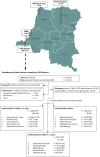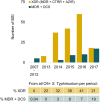Non-typhoidal Salmonella bloodstream infections in Kisantu, DR Congo: Emergence of O5-negative Salmonella Typhimurium and extensive drug resistance
- PMID: 32240161
- PMCID: PMC7156106
- DOI: 10.1371/journal.pntd.0008121
Non-typhoidal Salmonella bloodstream infections in Kisantu, DR Congo: Emergence of O5-negative Salmonella Typhimurium and extensive drug resistance
Abstract
Background: Non-typhoidal Salmonella (NTS) are a major cause of bloodstream infection (BSI) in sub-Saharan Africa. This study aimed to assess its longitudinal evolution as cause of BSI, its serotype distribution and its antibiotic resistance pattern in Kisantu, DR Congo.
Methods: As part of a national surveillance network, blood cultures were sampled in patients with suspected BSI admitted to Kisantu referral hospital from 2015-2017. Blood cultures were worked-up according to international standards. Results were compared to similar data from 2007 onwards.
Results: In 2015-2017, NTS (n = 896) represented the primary cause of BSI. NTS were isolated from 7.6% of 11,764 suspected and 65.4% of 1371 confirmed BSI. In children <5 years, NTS accounted for 9.6% of suspected BSI. These data were in line with data from previous surveillance periods, except for the proportion of confirmed BSI, which was lower in previous surveillance periods. Salmonella Typhimurium accounted for 63.1% of NTS BSI and Salmonella Enteritidis for 36.4%. Of all Salmonella Typhimurium, 36.9% did not express the O5-antigen (i.e. variant Copenhagen). O5-negative Salmonella Typhimurium were rare before 2013, but increased gradually from then onwards. Multidrug resistance was observed in 87.4% of 864 NTS isolates, decreased ciprofloxacin susceptibility in 7.3%, ceftriaxone resistance in 15.7% and azithromycin resistance in 14.9%. A total of 14.2% of NTS isolates, that were all Salmonella Typhimurium, were multidrug resistant and ceftriaxone and azithromycin co-resistant. These Salmonella isolates were called extensively drug resistant. Compared to previous surveillance periods, proportions of NTS isolates with resistance to ceftriaxone and azithromycin and decreased ciprofloxacin susceptibility increased.
Conclusion: As in previous surveillance periods, NTS ranked first as the cause of BSI in children. The emergence of O5-negative Salmonella Typhimurium needs to be considered in the light of vaccine development. The high proportions of antibiotic resistance are worrisome.
Conflict of interest statement
The authors have declared that no competing interests exist.
Figures






Similar articles
-
Invasive Salmonella Infections at Multiple Surveillance Sites in the Democratic Republic of the Congo, 2011-2014.Clin Infect Dis. 2015 Nov 1;61 Suppl 4:S346-53. doi: 10.1093/cid/civ713. Clin Infect Dis. 2015. PMID: 26449951
-
Microbiological, clinical and molecular findings of non-typhoidal Salmonella bloodstream infections associated with malaria, Oriental Province, Democratic Republic of the Congo.BMC Infect Dis. 2016 Jun 10;16:271. doi: 10.1186/s12879-016-1604-1. BMC Infect Dis. 2016. PMID: 27286886 Free PMC article.
-
Characterisation of community acquired non-typhoidal Salmonella from bacteraemia and diarrhoeal infections in children admitted to hospital in Nairobi, Kenya.BMC Microbiol. 2006 Dec 15;6:101. doi: 10.1186/1471-2180-6-101. BMC Microbiol. 2006. PMID: 17173674 Free PMC article.
-
Emergence of Community-Acquired, Multidrug-Resistant Invasive Nontyphoidal Salmonella Disease in Rural Western Kenya, 2009-2013.Clin Infect Dis. 2015 Nov 1;61 Suppl 4:S310-6. doi: 10.1093/cid/civ674. Clin Infect Dis. 2015. PMID: 26449946 Review.
-
Epidemiology and Genomics of Invasive Nontyphoidal Salmonella Infections in Kenya.Clin Infect Dis. 2015 Nov 1;61 Suppl 4(Suppl 4):S317-24. doi: 10.1093/cid/civ711. Clin Infect Dis. 2015. PMID: 26449947 Free PMC article. Review.
Cited by
-
Development of a rapid diagnostic test based on loop-mediated isothermal amplification to identify the most frequent non-typhoidal Salmonella serovars from culture.Eur J Clin Microbiol Infect Dis. 2023 Apr;42(4):461-470. doi: 10.1007/s10096-023-04571-3. Epub 2023 Feb 22. Eur J Clin Microbiol Infect Dis. 2023. PMID: 36810725 Free PMC article.
-
Genetic and Structural Variation in the O-Antigen of Salmonella enterica Serovar Typhimurium Isolates Causing Bloodstream Infections in the Democratic Republic of the Congo.mBio. 2022 Aug 30;13(4):e0037422. doi: 10.1128/mbio.00374-22. Epub 2022 Jul 18. mBio. 2022. PMID: 35862803 Free PMC article.
-
Salmonella enterica serovar Typhimurium ST313 sublineage 2.2 has emerged in Malawi with a characteristic gene expression signature and a fitness advantage.Microlife. 2024 Mar 28;5:uqae005. doi: 10.1093/femsml/uqae005. eCollection 2024. Microlife. 2024. PMID: 38623411 Free PMC article.
-
Direct association between rainfall and non-typhoidal Salmonella bloodstream infections in hospital-admitted children in the Democratic Republic of Congo.Sci Rep. 2021 Nov 3;11(1):21617. doi: 10.1038/s41598-021-01030-x. Sci Rep. 2021. PMID: 34732799 Free PMC article.
-
Antimicrobial Resistance Rates and Surveillance in Sub-Saharan Africa: Where Are We Now?Infect Drug Resist. 2022 Jul 7;15:3589-3609. doi: 10.2147/IDR.S342753. eCollection 2022. Infect Drug Resist. 2022. PMID: 35837538 Free PMC article. Review.
References
Publication types
MeSH terms
Substances
Associated data
LinkOut - more resources
Full Text Sources
Medical
Research Materials

